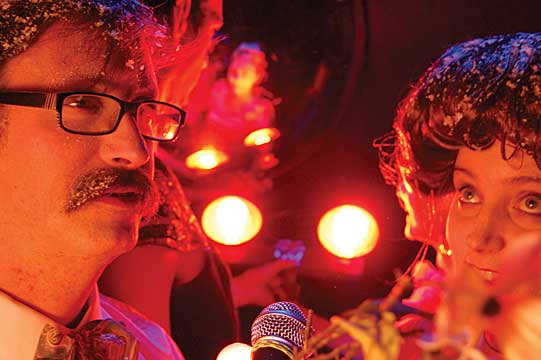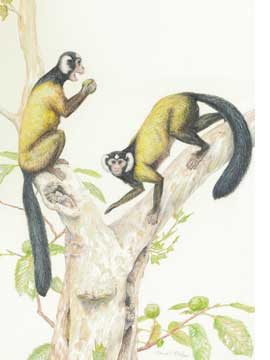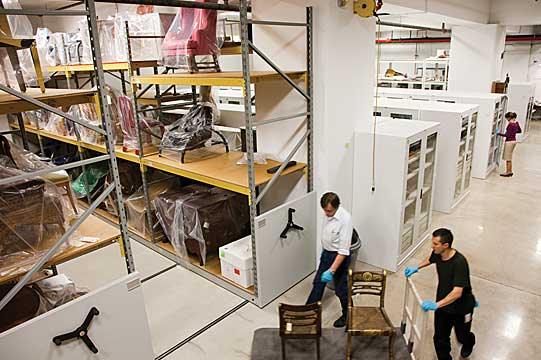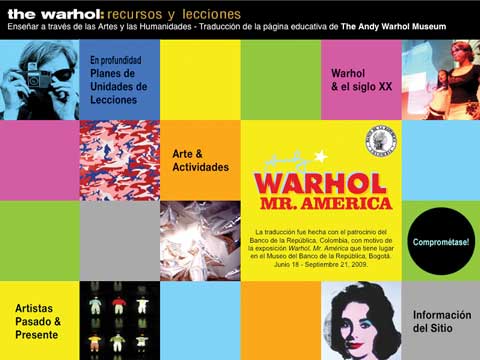 Fall 2009
Fall 2009|
Off the Wall … and into the spotlight
As a non-traditional performance-art venue, The Andy Warhol Museum is emerging no longer; it’s officially arrived. Earlier this year, thanks in no small way to its nationally recognized Off the Wall series, The Warhol became a new partner in the Spalding Gray Award consortium, joining performance-art heavyweights Performance Space 122 in New York City and The Walker Arts Center in Minneapolis.  Joseph Silovsky and Maggie Hoffman of RadioholeThe awards program was established three years ago in honor of famed performing artist Spalding Gray, who died in 2004 after earning notoriety for, among other things, writing and acting in the play Swimming to Cambodia. The partnership between the trio of venues and the Gray family is a win for Pittsburgh, too. This year’s award recipient, avant-garde New York theatre troupe Radiohole, will perform its newest work, Whatever, Heaven Allows, at all three venues, with the Pittsburgh performance scheduled for February of 2010. The star-spangled American meta-melodrama—inspired by film director Douglas Sirk’s 1950s potboilers, John Milton’s epic Paradise Lost, and American hit-makers Tom Petty and the Heartbreakers—is a lush, surreal, raw, and flat-out fun theater experience. Since 2000, Ben Harrison, The Warhol’s associate curator for performance, has been molding the Off the Wall series into something uniquely its own, supporting innovative, multi-disciplinary performance art that might otherwise never find a stage in Pittsburgh. The new partnership is a perfect next step in the evolution of the series. Check out Whatever, Heaven Allows at the New Hazlett Theater February 12-13. For tickets, call 412.237.8300 or visit www.ticketweb.com. Asia, not Africa, as our motherland?
Illustration: Mark A. Klingler Fossils recently discovered in Myanmar could prove that the common ancestors of humans, monkeys, and apes evolved from primates in Asia, not Africa. So says an international team of researchers, including Carnegie Museum of Natural History paleontologist Chris Beard. Fossils recently discovered in Myanmar could prove that the common ancestors of humans, monkeys, and apes evolved from primates in Asia, not Africa. So says an international team of researchers, including Carnegie Museum of Natural History paleontologist Chris Beard. “We’re 38 million years in the distant past and not even true apes have evolved yet,” says Beard, a world-renowned expert on the primate fossil record. “So this was quite an advanced monkey for that point in time. As far as we can tell, it has modern anatomy and was acting like a modern monkey.” The findings were published in the Proceedings of the Royal Society B, a London-based peer-reviewed journal. The team named the new primate Ganlea megacanina because it was found near the village of Ganle and had enlarged canine teeth. Wear and abrasion found on the teeth suggest the tree-dwelling, monkey-like creatures used their teeth to crack open tropical fruit to get to the pulp and seeds—behavior similar to modern South American saki monkeys that inhabit the Amazon basin, says Beard. This does not mean, however, that humans evolved in Asia, adds Beard. Ganlea and its ancestors likely moved to Africa well before the evolution of humans. “The question is when and how did this big evolutionary shift occur from Asia to Africa,” he says. The discovery also further calls into question the May unveiling of a nearly intact skeleton of a 47-million-year-old primate dubbed “Ida” that researchers touted as “our earliest ancestor.” “We wouldn't claim Ganlea is the missing link, but we know Ganlea is much more closely related to our ancestors than Ida ever was—even though, unfortunately, we don’t have a complete skeleton like they did for Ida,” says Beard. Carnegie Museums benefits from the best and the brightest
During its July board of trustees meeting, Carnegie Museums of Pittsburgh elected six new trustees. “Once again, our newly elected trustees represent the very best of the region’s corporate, educational, and cultural leaders,” said David M. Hillenbrand, president of Carnegie Museums. “We are extremely grateful to them for their willingness to serve Carnegie Museums and the Pittsburgh community through their volunteer leadership.” Joining the 70-member board as new term trustees are: Nicholas J. DeIuliis, chief operating officer, CONSOL Energy Inc.; James C. Diggs, senior vice president/general counsel, and secretary, PPG Industries, Inc.; George F. Eichleay, chief executive officer, Eichleay Engineers of California, Inc.; Sylvia V. Fields, executive director, Eden Hall Foundation; Albert J. Neupaver, president and chief executive officer, Wabtec Corporation; and David M. O’Brien, executive vice president, government services and external affairs, Highmark Inc. Hugh G. Van der Veer, Esquire, Buchanan Ingersoll & Rooney PC, was elected to his first full term as a trustee and R. Damian Soffer, president of the Soffer Organization, was elected to his second term. (Storage) space, the final frontier
 photo: Tom LittleWhen Jason Busch, The Alan G. and Jane A. Lehman Curator of Decorative Arts, joined Carnegie Museum of Art in 2006 (see also FACE TIME), most of the museum’s nearly 7,000 decorative arts and design objects were in temporary storage in the Ailsa Mellon Bruce Galleries. So before Busch could complete the long-awaited reinstallation of the Bruce Galleries, he had to create a long-term storage plan for the collection. Mission accomplished. The museum’s new Decorative Arts and Design Study and Storage (DASS), located in the basement of the Museum of Art’s Scaife Galleries, is a curator’s dream—which makes sense, since it was dreamed up by Busch, with top-notch assistance from Museum of Art colleagues and a group of decorative arts specialists from across the country. “We’ve created a facility that is safer and more secure than the original storage space and planned for at least a decade or more of growth,” says Busch, proudly. “We purchased state-of-the-art cabinets—some of them vented for the storing of organic material when it’s not on view—and installed compact shelving to accommodate the acquisition of larger-scale objects over time.” The sophisticated storage facility provides the most finicky of objects the climate protection they need. Busch notes that the space was put to the test immediately. “At the present moment the vast majority of our decorative arts and design collection is in DASS, so that is the true test as to whether or not the space suits our purposes,” he says, “and it truly does.” Powdermill: The natural party place
 It’s no secret the four Carnegie Museums rank among the coolest, smartest, and swankiest places in town to host fundraisers, wedding receptions, birthday or anniversary parties—even a G-20 spouses’ luncheon (First Lady Michelle Obama will play host at The Warhol on September 25). It’s no secret the four Carnegie Museums rank among the coolest, smartest, and swankiest places in town to host fundraisers, wedding receptions, birthday or anniversary parties—even a G-20 spouses’ luncheon (First Lady Michelle Obama will play host at The Warhol on September 25). Now the region’s event planners can add Powdermill Nature Reserve, the biological research station of Carnegie Museum of Natural History, to the area’s list of unique settings for special celebrations. Nestled in the Laurel Highlands, Powdermill’s 2,200 acres of woodlands, streams, open fields, and ponds create an unparalleled natural backdrop for intimate social gatherings or business conferences for nearly 200 people, thanks to its newly expanded education center and meeting space. With a variety of “green” indoor and outdoor meeting spaces, Powdermill’s offerings include a multipurpose conference center, avian exhibit room, and a spacious al fresco deck and courtyard. For more information about how to make Powdermill the “natural” choice for your next event, contact Cokie Lindsay at lindsayc@carnegiemnh.org or 724.593.4070. Traveling Warhol
 The current stop on Andy Warhol’s world tour: Bogotá, Colombia. This trip, he’s traveling by way of Mr. America, an exhibition titled in his honor and organized by the Art Museum of the Republic Bank in Bogotá and The Andy Warhol Museum. The show casts a wide lens on the Pop artist’s career and is the largest ever organized in a Latin American museum. It includes 26 paintings, 57 silkscreens, as well as two art installations, Silver Clouds and Cow Wallpaper. Fourteen of Warhol’s films are also being screened at a nearby venue. The joint venture runs through September 21. This latest international exhibition places a special emphasis on the work Warhol created in the 1960s, when he began his paintings of iconic American products and celebrities, from Campbell’s Soup cans to portraits of Marilyn Monroe and Elizabeth Taylor. It’s also the first time Colombians have viewed a complete survey of Warhol’s work in their homeland. “The most interesting thing for me would be to go back a year from now and see the impact the show, a first for a small country like Colombia, will have on its younger artists,” says Warhol Director Tom Sokolowski. “I can’t believe it wouldn’t have an impact, because it always does.” Next up, the exhibition hits the road with stops in Buenos Aires, Argentina, and San Paulo, Brazil. In preparation, The Warhol’s education department is offering a new Spanish edition of its online curriculum, Warhol: Resources & Lessons, inviting Latin American teachers to use Andy Warhol’s life, art, and practice to teach not only art but across the humanities. |
Also in this issue:
Poster Boy · The Whales' Tale · Insect Appellant · Destination Pittsburgh · Presidentís Note · Now Showing · Face Time: Jason Busch · About Town: The Art of Change · Field Trip: Virtual Field Trip · Science & Nature: Robots Rule · Artistic License: Word Play · The Big Picture
 |
Copyright © 2017 CARNEGIE Magazine. All rights reserved. |
